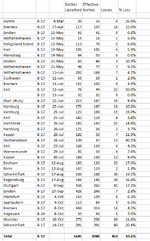In RAF Bomber Command, the increase in "Main Force" Lancaster crew size to 8 crew members typically occurred with an experienced crew taking a second pilot on a combat operation for him to gain battle experience prior to going out with his "sprog" crew. They were referred to as "Second Dickie" trips. In most cases pilots in training did one of these. In some cases two. In other cases, the Main Force Crew carried someone from "Group". Air Vice Marshall McEwen, did at least 3 trips as a "2nd pilot" on operations.
Pathfinder Crews might carry a 2nd navigator/bomb aimer on regular occasions. The 7 Squadron ORB records some crews included 8 crewmen in February 1945 with an extra crewman called a "Visual Bomber", in addition to an "Air Bomber" and a Navigator. I surmise that the task of the Visual Bomber was in the standard role, using a bomb sight, whereas the role of the "Air Bomber" was as a H2S Mk III set operator for blind bombing. More research is required to verify this, however we do know that on most crews, the Bomb Aimer was "Set Operator". Pathfinders also carried a 2nd pilot on occasion, again, probably a pilot training for Pathfinder Force.
Jim
Pathfinder Crews might carry a 2nd navigator/bomb aimer on regular occasions. The 7 Squadron ORB records some crews included 8 crewmen in February 1945 with an extra crewman called a "Visual Bomber", in addition to an "Air Bomber" and a Navigator. I surmise that the task of the Visual Bomber was in the standard role, using a bomb sight, whereas the role of the "Air Bomber" was as a H2S Mk III set operator for blind bombing. More research is required to verify this, however we do know that on most crews, the Bomb Aimer was "Set Operator". Pathfinders also carried a 2nd pilot on occasion, again, probably a pilot training for Pathfinder Force.
Jim

